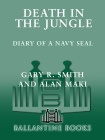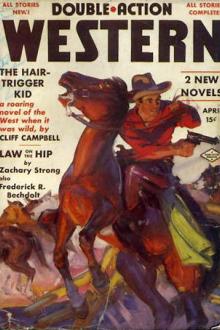Death in the Jungle by Gary Smith (most inspirational books .txt) 📕

Read free book «Death in the Jungle by Gary Smith (most inspirational books .txt) 📕» - read online or download for free at americanlibrarybooks.com
- Author: Gary Smith
Read book online «Death in the Jungle by Gary Smith (most inspirational books .txt) 📕». Author - Gary Smith
Fire team: A subdivision of a squad. There were two fire teams per SEAL squad.
Flankers: Men of elements deployed to the sides of a moving formation to provide early warning of an enemy ambush.
Flank speed: A certain prescribed speed increase over standard speed; faster than full speed, but less than emergency full speed.
Flood tide: Tide rising or flowing toward land.
Fore and aft: Running in the direction of the keel.
Forward: Toward the bow; opposite of aft.
Founder: To sink.
Gale: A wind between a strong breeze and a storm; wind force of 28 to 55 knots.
Galley: The ship’s kitchen or any area designated as such by Team personnel.
Gangplank or brow: Moveable bridge leading from a ship to a pier, wharf, or float; usually equipped with rollers on the bottom and handrails on the side. Occasionally used at Team parties as punishment/reward for one reason or another.
Gangway: Opening in the bulwarks or the rail of the ship to give entrance; also, an order to stand aside and get out of the way.
Garble: An unintentional mix-up of a message’s contents.
Gear: General term for lines, ropes, blocks, fenders, et cetera; personal effects.
General alarm: Sound signals used for general quarters and other emergencies.
General quarters: Battle stations for all hands.
Go adrift: To break loose; a teammate’s getting hooked on wine, women, or booze.
Granny knot: A knot similar to a square knot; does not hold under strain. Some individuals could be considered no better than a granny knot.
Grenadier: Usually carried an M-79 grenade launcher or an M-16/XM-148. There were usually at least two grenadiers per SEAL platoon, and they were placed near the center of the patrol for tactical mobility. The grenadier’s main responsibility was to neutralize heavy pockets of enemy resistance as directed by the patrol leader.
Gunwale: Upper edge or rail of a ship’s or boat’s side. Pronounced “gunnel.”
Hail: To address a nearby boat or ship. Also a ship or man is said to hail from such-and-such a home port or home town.
Hangfire: Gun charge that does not fire immediately upon pulling the trigger, but some time later. Occasionally, hangfires happened to Team ammo that had spent too much time in water.
Hatch: An opening in the ship’s deck, for communication or for handling stores and cargo.
Head/john/latrine: Compartment of a ship or plane, or any designated area, having toilet facilities.
Headroom: Clearance between decks.
Headway: Forward motion of a ship, boat, rubber raft, et cetera.
Heave: To throw or toss; to pull on a line.
Hitch: General class of knots by which a line is fastened to another object, either directly to or around it. Also, a term of enlistment (slang).
Hold: Space below decks for storage of ballast, cargo, et cetera.
Holiday routine: Routine followed aboard ship on authorized holidays and Sundays. In the Teams, it was any day of the week on which to have fun. Every day was a holiday, and every meal was a feast.
Hootch: In Vietnam, a rural home made mostly of palm thatching. It usually had one or two windows with shutters. It was cool during the dry season, and warm in the rainy season. The floor was usually dirt. Sometimes, a family bunker was constructed inside the hootch. The mamma-san kept it tidy by sweeping the interior daily. The little crock charcoal stove was usually located in the corner of the floor. The simple bed may have been the only other piece of furniture in the home, and it was without a mattress; however, it did have several pillows stuffed with rice chaff.
Hug: To keep close. A vessel might hug the shore. In the Teams a hug was a form of greeting.
IBS: A seven-person boat, inflated with carbon-dioxide cartridges, referred to as an “Inflatable Boat, Small” (hence, “IBS”). It was designed and procured by the U.S. Navy as an emergency lifeboat for seagoing vessels. Since its introduction and application to the Navy’s Underwater Demolition and SEAL Teams, it had been utilized for various surface uses. It could also be rigged with a parachute and dropped from an aircraft, or (with minor valve modifications) launched and recovered from the deck of a submerged submarine. The IBS could carry seven men and one thousand pounds of equipment.
Insertion/extraction: Going into and coming out of danger areas (see danger areas). Some examples of clandestine and covert insertion and extraction vehicles and methods were: boat, sampan, helicopter, truck, jeep, bus, motorcycle, parachute, patrolling, swimming, SDV (swimmer delivery vehicle), Lambretta, rappelling, and even a refrigeration truck.
Inshore: Toward land.
Irish pennant: Unseamanlike, dangling loose end of a line or piece of bunting.
Jack-o’-the-dust: Enlisted man serving as assistant to the ship’s cook.
Jacob’s ladder: Light ladder made of rope or chain with metal or wooden rungs; used over the side, aloft, or hanging from the bottom of a helicopter.
Jettison: Goods cast overboard to lighten a ship or boat in distress.
Jetty: Breakwater built to protect a harbor entrance or river mouth.
Jury rig: Makeshift rig of mast and sail, or of other gear, as jury anchor, jury rudder; any makeshift device.
K-bar: A knife long used by the Teams and the Marine Corps. It was not made for knife throwing. It had a nasty tendency to break just forward of the handle.
Keelhaul: To reprimand severely.
Kill zone: In a point ambush, the area where the central portion of the enemy force was caught. It was also an area where the AW and the grenadier could inflict the most casualties upon the enemy and, at the same time, maintain fire superiority. All other riflemen would concentrate their semiautomatic fire within the kill zone and maintain a sustained rate of fire.
Knot: One nautical mile (6080.2 feet) per hour. (Never say “knots per hour.” This would be the same as saying “miles per hour per hour.”) Also, a knob, tie, or fastening formed with rope.
Ladder: In a ship, corresponds to stairs in a building.
Landmark: Any conspicuous object on shore, used for piloting.
Lanyard: A line made fast to an article for securing it; for example, a knife lanyard, bucket lanyard.
Lash: To





Comments (0)